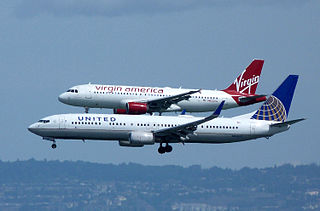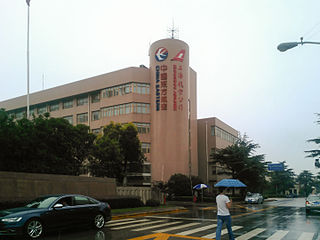
An airliner is a type of aircraft for transporting passengers and air cargo. Such aircraft are most often operated by airlines. The modern and most common variant of the airliner is a long, tube shaped, and jet powered aircraft. The largest of them are wide-body jets which are also called twin-aisle because they generally have two separate aisles running from the front to the back of the passenger cabin. These are usually used for long-haul flights between airline hubs and major cities. A smaller, more common class of airliners is the narrow-body or single-aisle. These are generally used for short to medium-distance flights with fewer passengers than their wide-body counterparts.

The Boeing 777, commonly referred to as the Triple Seven, is an American long-range wide-body airliner developed and manufactured by Boeing Commercial Airplanes. The 777 is the world's largest twinjet and the most-built wide-body airliner. The jetliner was designed to bridge the gap between Boeing's other wide body airplanes, the twin-engined 767 and quad-engined 747, and to replace aging DC-10 and L-1011 trijets. Developed in consultation with eight major airlines, the 777 program was launched in October 1990, with an order from United Airlines. The prototype was rolled out in April 1994, and first flew in June. The 777 entered service with the launch operator United Airlines in June 1995. Longer-range variants were launched in 2000, and first delivered in 2004.

Emirates is one of two flag carriers of the United Arab Emirates. Based in Garhoud, Dubai, the airline is a subsidiary of The Emirates Group, which is owned by the government of Dubai's Investment Corporation of Dubai. It is the largest airline in the Middle East, operating over 3,600 flights per week from its hub at Terminal 3 of Dubai International Airport. It operates to more than 150 cities in 80 countries across six continents on its fleet of nearly 300 aircraft. Cargo activities are undertaken by Emirates SkyCargo.

Singapore Airlines is the flag carrier of Singapore with its hub located at Changi Airport, and a member of the Star Alliance. The airline is notable for highlighting the Singapore Girl as its central figure in the corporate branding segment. Widely renowned as one of the best carriers, the airline is ranked as a 5-star airline by Skytrax, and it has also been ranked as the world's best airline five times. The airline operates a variety of Airbus and Boeing aircraft, namely the A350, A380, Boeing 737, Boeing 747 Freighter, Boeing 777 and Boeing 787.

The Airbus A340 is a long-range, wide-body passenger airliner that was developed and produced by Airbus. In the mid-1970s, Airbus conceived several derivatives of the A300, its first airliner, and developed the A340 quadjet in parallel with the A330 twinjet. In June 1987, Airbus launched both designs with their first orders and the A340-300 took its maiden flight on 25 October 1991. It was certified along with the A340-200 on 22 December 1992 and both versions entered service in March 1993 with launch customers Lufthansa and Air France. The larger A340-500/600 were launched on 8 December 1997; the A340-600 flew for the first time on 23 April 2001 and entered service on 1 August 2002.
All Nippon Airways Co., Ltd. is a Japanese airline headquartered in Minato, Tokyo, ANA operates services to both domestic and international destinations and is Japan's largest airline, ahead of its main rival flag carrier Japan Airlines. As of April 2023, the airline has approximately 12,800 employees. The airline joined as a Star Alliance member in October 1999.
Philippine Airlines (PAL) is the flag carrier of the Philippines. Headquartered at the PNB Financial Center in Pasay, the airline was founded in 1941 and is the oldest operating commercial airline in Asia.
World Airways, Inc. was an American airline headquartered in Peachtree City, Georgia in Greater Atlanta. The company operated mostly non-scheduled services but did fly scheduled passenger services as well, notably with McDonnell Douglas DC-10 wide body jetliners. World Airways ceased all operations on March 27, 2014.
EVA Airways Corporation is a Taiwanese airline headquartered in Taoyuan City. It is one of the two largest airlines in Taiwan along with state-owned China Airlines. The privately-owned airline operates passenger and dedicated cargo services to over 40 international destinations in Asia, Australia, Europe & North America. Its network fully consists of international routes, with no domestic routes. It is rated as a 5-star airline by Skytrax, and is the second largest airline based in Taiwan after China Airlines. EVA Air is headquartered at Taoyuan International Airport in Luzhu, Taoyuan City. The company slogan is "Sharing the World, Flying Together".
Qatar Airways Company Q.C.S.C., operating as Qatar Airways, is the flag carrier of Qatar. Headquartered in the Qatar Airways Tower in Doha, the airline operates a hub-and-spoke network, flying to over 170 international destinations across five continents from its base at Hamad International Airport. The airline currently operates a fleet of more than 200 aircraft. Qatar Airways Group employs more than 43,000 people. The carrier has been a member of the Oneworld alliance since October 2013, and the official company slogan has been "Going Places Together" since 2015.

China Eastern Airlines Corporation Limited is an airline headquartered in the China Eastern Airlines Building, on the grounds of Shanghai Hongqiao International Airport in Changning, Shanghai, China. It is one of the "Big Three" airlines of the People's Republic of China, operating international, domestic and regional routes. China Eastern's main hubs are Shanghai Pudong Airport and Hongqiao Airport.

The Airbus A350 is a long-range, wide-body twin-engine airliner developed and produced by Airbus. The initial A350 design proposed by Airbus in 2004, in response to the Boeing 787 Dreamliner, would have been a development of the Airbus A330 with composite wings and new engines. Due to inadequate market support, Airbus switched in 2006 to a clean-sheet "XWB" design, powered by two Rolls-Royce Trent XWB high bypass turbofan engines. The prototype first flew on 14 June 2013 from Toulouse, France. Type certification from the European Aviation Safety Agency (EASA) was obtained in September 2014, followed by certification from the Federal Aviation Administration (FAA) two months later.
AD Aerospace are involved in Aircraft Video Surveillance and form part of the Mythra Group of companies.

TAAG Angola Airlines E.P. is a state-owned airline and flag carrier of Angola. Based in Luanda, the airline operates domestic services within Angola, medium-haul services in Africa and long-haul services to Brazil, Cuba, and Portugal. The airline was originally set up by the government as DTA – Divisão dos Transportes Aéreos in 1938, rechristened TAAG Angola Airlines in 1973, and gained flag carrier status in 1975. It is now a member of both the International Air Transport Association and the African Airlines Association.

An airline seat is a seat on an airliner in which passengers are accommodated for the duration of the journey. Such seats are usually arranged in rows running across the airplane's fuselage. A diagram of such seats in an aircraft is called an aircraft seat map.

Aircraft emergency oxygen systems or air masks are emergency equipment fitted to pressurized commercial aircraft, intended for use when the cabin pressurisation system has failed and the cabin altitude has climbed above a safe level. It consists of a number of individual yellow oxygen masks stored in compartments near passenger seats and near areas like lavatories and galleys, and an oxygen source, like a centralized gaseous cylinder or decentralized chemical oxygen generator.
AeroMobile Communications Limited is a registered mobile network operator for the aviation industry and is based in the UK. It provides technology and services that allow the safe use of passengers' own mobile phones while inflight. A subsidiary of Panasonic Avionics Corporation its services are often installed alongside Panasonic's Wi-Fi network and can be installed either at the point of aircraft manufacture or retro-fitted across both Airbus and Boeing aircraft. Panasonic Avionic's Wi-Fi network and AeroMobile's mobile phone network are complimentary services and provide passengers with a choice of inflight connectivity options.

First class is a travel class on some passenger airliners intended to be more luxurious than business class, premium economy, and economy class. Originally all planes offered only one class of service, with a second class appearing first in 1955 when TWA introduced two different types of service on its Super Constellations.
Longhao Airlines (Air Central) (IATA: GI, ICAO: LHA) is a cargo airline. It was formerly known as China Central Longhao Airlines (China Central Longhao Airlines was formerly known as Guangdong Longhao Airlines), established in August 2015 with registered capital of 400 million yuan. It was acquired by Henan Civil Aviation Development & Investment Group in June 2019.
Thai Airways International operates a fleet of wide-body and narrow-body aircraft from Airbus and Boeing.











